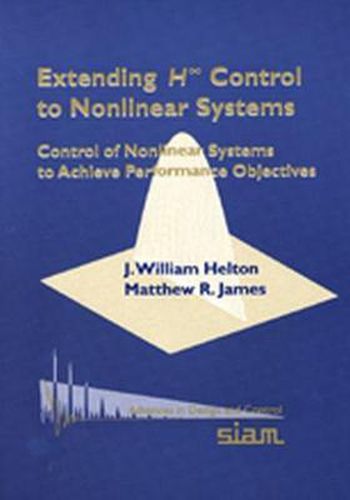Readings Newsletter
Become a Readings Member to make your shopping experience even easier.
Sign in or sign up for free!
You’re not far away from qualifying for FREE standard shipping within Australia
You’ve qualified for FREE standard shipping within Australia
The cart is loading…






H* control originated in an effort to codify classical control methods where one shapes frequency response functions to meet certain objectives. H* control underwent tremendous development in the 1980s and made considerable strides toward systematizing classical control. This book addresses the next major issue - how this extends to nonlinear systems. At the core of nonlinear control theory lie two partial differential equations (PDEs). One is a first order evolution equation called the information state equation, which constitutes the dynamics of the controller. One can view this equation as a nonlinear dynamical system, such as the nature of trajectories, stability and, most importantly, how it leads to a general solution of the nonlinear H* control problem. The book also emphasizes theory that effects computer solvability. It shows that, surprisingly, the information state equation, which at the outset looks numerically intractable, is in many cases tractable. For example, the theory shows that careful initialization has a major infuence on computer solvability. The second PDE actually is a classical type of partial differentiation inequality (PDI), called a Bellman Issacs inequality. While the information state PDE determines the dynamics of the controller, the PDI determines the output of the controller. The authors explore the system theoretic significance of the PDI and present its gross structure. These equations are only a few years old and so their study is a wide open area of research. The authors have kept this book self-contained by using the appendices to help explain certain prerequisite material. The reader should have a basic knowledge of control theory, real analysis and differential equations, nonlinear operator theory and nonlinear PDE. Researchers in control theory, ODE and dynamical systems, and nonlinear estimation will be most interested in this book. Control theory is applied in a wide range, in particular, electrical, mechanical, aerospace, chemical and manufacturing/industrial engineering. Anyone doing research in an area of mathematics and engineering specialties should also find the book of interest.
$9.00 standard shipping within Australia
FREE standard shipping within Australia for orders over $100.00
Express & International shipping calculated at checkout
H* control originated in an effort to codify classical control methods where one shapes frequency response functions to meet certain objectives. H* control underwent tremendous development in the 1980s and made considerable strides toward systematizing classical control. This book addresses the next major issue - how this extends to nonlinear systems. At the core of nonlinear control theory lie two partial differential equations (PDEs). One is a first order evolution equation called the information state equation, which constitutes the dynamics of the controller. One can view this equation as a nonlinear dynamical system, such as the nature of trajectories, stability and, most importantly, how it leads to a general solution of the nonlinear H* control problem. The book also emphasizes theory that effects computer solvability. It shows that, surprisingly, the information state equation, which at the outset looks numerically intractable, is in many cases tractable. For example, the theory shows that careful initialization has a major infuence on computer solvability. The second PDE actually is a classical type of partial differentiation inequality (PDI), called a Bellman Issacs inequality. While the information state PDE determines the dynamics of the controller, the PDI determines the output of the controller. The authors explore the system theoretic significance of the PDI and present its gross structure. These equations are only a few years old and so their study is a wide open area of research. The authors have kept this book self-contained by using the appendices to help explain certain prerequisite material. The reader should have a basic knowledge of control theory, real analysis and differential equations, nonlinear operator theory and nonlinear PDE. Researchers in control theory, ODE and dynamical systems, and nonlinear estimation will be most interested in this book. Control theory is applied in a wide range, in particular, electrical, mechanical, aerospace, chemical and manufacturing/industrial engineering. Anyone doing research in an area of mathematics and engineering specialties should also find the book of interest.